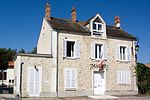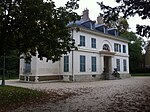The Île-de-France (, French: [il də fʁɑ̃s] ; literally "Island of France") is the most populous of the eighteen regions of France, with an official estimated population of 12,271,794 residents on 1 January 2023. Centred on the capital Paris, it is located in the north-central part of the country and often called the Paris Region (French: Région parisienne, pronounced [ʁeʒjɔ̃ paʁizjɛn]). Île-de-France is densely populated and retains a prime economic position on the national stage: though it covers only 12,012 square kilometres (4,638 square miles), about 2% of metropolitan French territory, its 2017 population was nearly one-fifth of the national total.The region is made up of eight administrative departments: Paris, Essonne, Hauts-de-Seine, Seine-Saint-Denis, Seine-et-Marne, Val-de-Marne, Val-d'Oise and Yvelines. It was created as the "District of the Paris Region" in 1961. In 1976, when its status was aligned with the French administrative regions created in 1972, it was renamed after the historic province of Île-de-France. Residents are sometimes referred to as Franciliens, an administrative word created in the 1980s. The GDP of the region in 2019 was nearly one-third of the French,: 12 and 5% of the European Union's.: 12 It has the highest per capita GDP of any French region and the third highest of any region in the European Union.Beyond the city limits of Paris, the region has many other important historic sites, including the palaces of Versailles and Fontainebleau, as well as the most-visited tourist attraction in France, Disneyland Paris. Though it is the richest French region, a significant number of residents live in poverty: the official poverty rate in the Île-de-France was 15.9% in 2015. The region has witnessed increasing income inequality in recent decades and rising housing prices have pushed the less affluent outside Paris.









